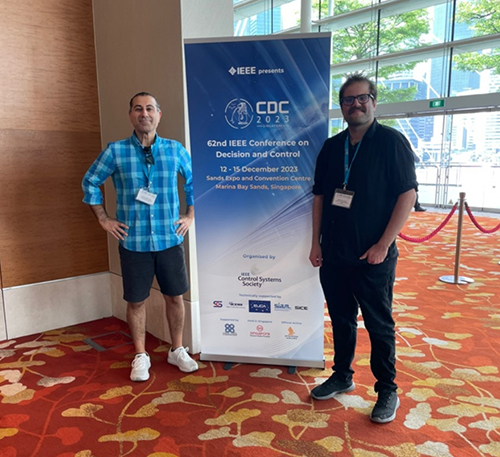WKU News
Multidisciplinary Milestone: Professor's Research with Former Graduate Student, Earns Global Recognition
- Tuesday, January 9th, 2024

In a significant leap toward multidisciplinary innovation, Professor Ahmet Ozkan Ozer and his dedicated research group have received dual recognition for their pioneering research. Their innovative model reduction technique, rooted in recently funded RCAP and KY NSF EPSCoR grants, has earned accolades in IEEE Control Systems Letters (L-CSS) and ESAIM: Control, Optimisation, and Calculus of Variations (ESAIM: COCV). This acknowledgment not only underscores the versatility of their work but also extends its implications beyond control engineering. Notably, the IEEE, the world's largest technical professional organization dedicated to advancing technology for the benefit of humanity, recognizes the transformative potential of Ozer's work.
Navigating Challenges in Model Reduction for Partial Differential Equations (PDEs): The research encountered hurdles in guaranteeing the exact observability (essential for the sensor design) of the Partial Differential Equation (PDE) model for a multilayer smart laminate, especially as mesh parameters approached zero post model reduction. Conventional model reduction techniques faced difficulties in these scenarios, compelling the research group to formulate innovative solutions.
Novel Solutions Uncovered: In response to these challenges, the researchers introduced a novel model reduction approach. Leveraging the direct Fourier filtering technique, they maintained exact observability even as the mesh parameter approached zero. Simultaneously, an alternative model reduction method was explored, involving a reduction in the order of the model, both in time spatial variables, through equidistant grid points and averaging operators.
Advancements in Beam Equations: This novel approach exhibited exceptional results, ensuring exact observability uniformly regardless of the proximity of the mesh parameter to zero. Importantly, it showcased its effectiveness without necessitating additional numerical filtering, highlighting its optimality. Collaborative efforts by Ahmet Kaan Aydin and Jacob Walterman played a crucial role in refining existing results for standard Euler-Bernoulli and Rayleigh beam equations. The research group meticulously analyzed the system matrix's spectrum, employing the discrete multipliers approach to enhance their findings.
Validation through Numerical Simulations: The research extended beyond theoretical achievements, incorporating practical validations through numerical simulations. Additionally, the research group utilized interactive simulations (Demonstration Projects) by Wolfram’s Mathematica, providing a comprehensive understanding of the strength and effectiveness of the introduced model reduction techniques.
Global Spotlight at IEEE CDC 2023: Adding to the accolades, the results of their research were presented at the 62nd IEEE Conference on Decision and Control (CDC 2023). Held at the Marina Bay Sands in Singapore from December 13 through December 15, 2023, the IEEE CDC serves as a premier scientific and engineering conference dedicated to advancing the theory and practice of systems and control.
Significance of IEEE CDC: The IEEE CDC annually brings together an international community of researchers and practitioners in the field of automatic control. It serves as a platform for discussing new research results, offering perspectives on future developments, and exploring innovative applications relevant to decision making, automatic control, and related areas.
Contributions to Decision Making and Automatic Control: Ozer's research, presented at the IEEE CDC 2023, significantly contributes to the overarching themes of decision making and automatic control. By sharing their findings on the global stage, the research group solidifies the importance of their model reduction technique in shaping the future of systems and control.
Successful Implementation for Strongly Coupled Piezoelectric Beam Equations: Extending their innovations, the research group successfully implemented the model reduction technique for strongly coupled piezoelectric beam equations. The results of this extension, including the significant contributions of Md Rafi Emran, have been submitted to a journal and are currently under revision. Importantly, the research on piezoelectric beams served as the thesis work of the recently graduate Md Rafi Emran, highlighting the educational significance of the work.
Implications for Serially Connected Multi-Layer Designs: Ozer's research holds significant promise for practical applications, notably in the realm of robotics, specifically serially connected multi-layer designs like those found in robotic hands and fingers. Collaborating with UPHF colleagues in France, Prof. Ozer actively contributed to a three-day conference on controlling Partial Differential Equations (PDEs) during his stay. In these designs, comprising alternating piezoelectric (a smart material) and conventional elastic beams, the mechanical deformation induced by the elastic beam's longitudinal vibrations causes each outer piezoelectric beam to stretch or shrink accordingly. This transformative process leads to the separation and alignment of charges, generating an electric field (voltage) in their respective electrodes.
International Collaboration in Germany: Ozer's six-month visit to Friedrich-Alexander-Universität Erlangen-Nürnberg in Germany, as part of his sabbatical leave, aimed at fostering international collaboration. The visit included an invited talk, contributing to the exchange of ideas in Dynamics Control, Machine Learning, and Numerics. This collaborative effort enriched the research landscape and facilitated a dynamic exchange of ideas.
Acknowledgment of High-Quality Student Work: The success of Ozer's research is a testament to the contributions of his team, including Md Rafi Emran and Ahmet Kaan Aydin, a John D. Minton awardee and current PhD student at UMBC, brings expertise to the research group. Jacob Walterman, a double major in Mathematics and Computer Science, supported by the FUSE grant at Western Kentucky University, showcases a diverse skill set nurtured under Ozer's guidance.
Extended Impact on Education: The influence of the research goes beyond published works, integrating itself into academic education. Notably, it takes center stage in the thesis work of Md Zulfiqur Haider, a current graduate student at WKU, underscoring its immediate impact and educational significance. Concurrently, another team, under the guidance of Ozer, is exploring alternative applications of piezoelectric beams, experimenting with different controllers and observers in diverse settings. This project involves the existing graduate students Uthman Rasaq and Md Ibrahim Khalilullah.
Ongoing Impact and Collaborative Potential: As the research progresses, the team remains committed to contributing meaningfully. Their model reduction technique holds promise for practical applications in robotics, and they look forward to potential collaborations and cross-disciplinary exploration. The ongoing impact of this research underscores the commitment to excellence demonstrated by Ozer and his research group, setting a trajectory for transformative contributions in multidisciplinary research.

